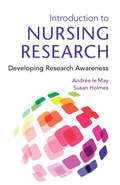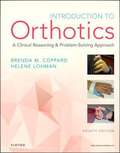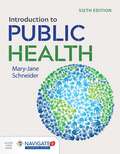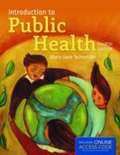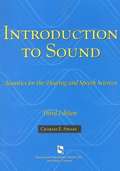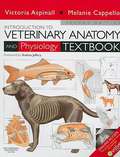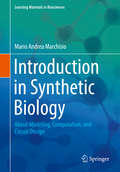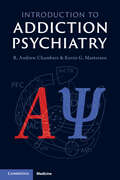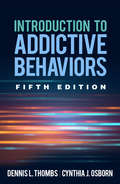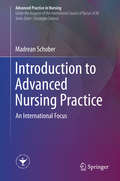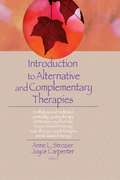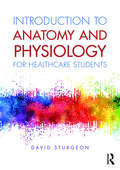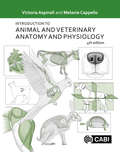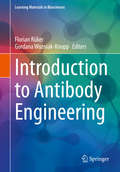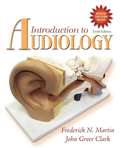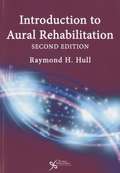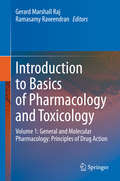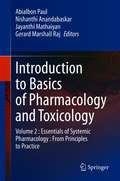- Table View
- List View
Introduction To Nursing Research: Developing Research Awareness
by Susan Holmes Andree le MayIn an engaging and accessible introduction for student nurses, Introduction to Nursing Research: Developing Research Awareness explains the hows and whys of nursing research, stressing its influence on policy and improving patient care. The book delivers a comprehensive guide to the research process and addresses questions such as: What is research
Introduction To Occupational Therapy
by Jane Clifford O'BrienPrepare for success in OT practice with a complete overview of the profession! Introduction to Occupational Therapy, 5th Edition helps you master the roles and responsibilities of the OT practitioner. Content promotes evidence-based OT practice, from client evaluation to planning interventions and goals to reaching optimal outcomes. You’ll also learn valuable skills in clinical reasoning and in providing occupational therapy across the client’s entire lifespan. Written by experienced educator and author Jane Clifford O’Brien, this comprehensive resource discusses today’s OT treatment settings and adds a new chapter on cultural competence.
Introduction To Orthotics: A Clinical Reasoning And Problem-solving Approach (Fourth Edition)
by Brenda M. Coppard Helene LohmanCovering the theory, design, and fabrication of orthotic devices, Introduction to Orthotics: A Clinical Reasoning & Problem-Solving Approach, 4th Edition helps you master the skills you need to choose and fit effective orthoses for patients with hand injuries and functional deficits. It emphasizes upper extremity splinting, with additional coverage of lower extremity orthotics and upper extremity prosthetics, and offers case studies promoting clinical reasoning and problem solving. This edition includes new chapters on orthotics of the shoulder and orthotic systems, plus online videos demonstrating fabrication and fitting techniques. Written by occupational therapy educators Brenda Coppard and Helene Lohman, this textbook/workbook is ideal for students and as a practical resource for occupational therapists and therapy assistants in the clinical setting.
Introduction To Public Health
by Mary-Jane SchneiderIncludes newly updated bonus e-chapter on Learning from the COVID-19 Pandemic. Offering a thorough, accessible and lively overview of public heath for students new to the field, Introduction to Public Health offers a broad-reaching, practical framework for understanding the forces and organizations of public health today. Through engaging, nontechnical language, illustrative real world examples, and the current political, economic, and cultural news of the day, students gain a clear understanding of the scope of today's public health problems and possible solutions.
Introduction To Public Health 4th Edition
by Mary-Jane SchneiderIntroduction to Public Health, Fourth Edition offers a thorough, accessible overview of the expanding field of public health for students new to its concepts and actors. Written in engaging, nontechnical language, this best-selling text explains in clear terms the multi-disciplinary strategies and methods used for measuring, assessing, and promoting public health. Packed with illustrative real-world examples, this updated edition provides students with informative discussions of the current technical issues and practical obstacles facing public health practitioners and policymakers alike. Through coverage of new approaches to research and data collection, current best practices in the field, and the social and ethical challenges of devising public policy, Introduction to Public Health, Fourth Edition provides readers with a broad-reaching, practical framework for understanding the multifaceted forces and organizations of today's public health enterprise.
Introduction To Sound: Acoustics For The Hearing And Speech Sciences (Singular Textbook Series)
by Charles E. SpeaksThis book constitutes the thoroughly refereed post-conference proceedings of the 7th International Conference on Global Security, Safety, and Sustainability (ICDS3), and of the 4th e-Democracy Joint Conferences (e-Democracy 2011) which were held in Thessaloniki in August 2011. <P><P>The 37 revised full papers presented were carefully selected from numerous submissions. Conference papers promote research and development activities of innovative applications and methodologies and applied technologies.
Introduction To Veterinary Anatomy And Physiology Textbook
by Victoria Aspinall Melanie CappelloA sound knowledge of anatomy and physiology is an essential basis for the effective clinical treatment of companion animals. The new Introduction to Veterinary Anatomy and Physiology Textbook builds on the success of the first edition in its thorough coverage of the common companion animal species. Updated throughout, the new edition features online learning resources, providing students with the opportunity to test their knowledge with questions and visual exercises, while instructors can download questions, figures and exercises to use as teaching aids. An essential first purchase for all those embarking upon a veterinary career Now with on-line resources including self-assessment tools and teaching aids Comprehensive coverage of all major companion animal species New equine chapter 'Applied Anatomy' tips relate theory to clinical practice, showing the relationship between anatomy and physiology and the disease process
Introduction To Veterinary Science
by MeeCee Baker James LawheadAn author team combining the technical experiences of a veterinarian working in clinical practice and a 20-year veteran teacher who knows what works in material delivery created this accurate, easy-to-use text, unlike any other of its kind. Starting with an overview of career opportunities available in the veterinary science, the chapters detail topics on cells, tissues, systems, nutrition, species comparison, principles of disease, disease prevention and diagnosis, zoonotic disease, surgery, and economic decision-making in veterinary practice. Each chapter features "A Day in the Life of a Veterinarian" vignette that relays James Herriot-type stories with relevance to clinical practice, and makes the text interesting and informative to students. Accompanying the text are numerous ancillary materials. Detailed lesson plans are available, and a master materials list will allow instructors to refer to one source when ordering annual supplies, with both of these elements saving valuable instruction time. A coordinating lab manual and end-of-chapter activities allow students to put technical know-how to practice, as labs and activities have all been piloted in classrooms. A test bank supplements end-of-chapter questions and tests, and these tests are available on disk and hard copy so instructors can create exams, or use the copy ready variety. This introductory text is geared toward high school and junior colleges, yet appropriate for any entry-level veterinary science course.
Introduction in Synthetic Biology: About Modeling, Computation, And Circuit Design (Learning Materials in Biosciences)
by Mario Andrea MarchisioThe textbook is based on the lectures of the course “Synthetic Biology” for Master’s students in biology and biotechnology at the Harbin Institute of Technology. The goal of the textbook is to explain how to make mathematical models of synthetic gene circuits that will, later on, drive the circuit implementation in the lab. Concepts such as kinetics, circuit dynamics and equilibria, stochastic and deterministic simulations, parameter analysis and optimization are presented. At the end of the textbook, a chapter contains a description of structural motifs (e.g. positive and negative feedback loops, Boolean gates) that carry out specific functions and can be combined into larger networks. Moreover, several chapters show how to build up (an analyse, where possible) models for synthetic gene circuits with four different open-source software i.e. COPASI, XPPAUT, BioNetGeN, and Parts & Pools-ProMoT.
Introduction to Addiction Psychiatry
by R. Andrew Chambers Kevin G. MastersonThis essential, concept-oriented book provides a highly integrative and translational approach to addiction, offering a deep understanding of the condition and its close biological-causal-developmental linkage with mental illness. The book explains addiction around five fundamental components that define disease: 1) Population Impact; 2) Symptom Sets; 3) Disorder of Anatomical Structure and Function; 4) Biological Risk Amplification; and 5) Diagnosis and Treatment. Key evidence and concepts from basic neuroscience are translated to epidemiological, clinical-observational, and treatment levels. The book discusses the broad reach and potent clinical capabilities of addiction psychiatry teams using integrative diagnostics and multi-dimensional treatment plans for patients across the entire addiction-mental illness spectrum. It introduces science-based psychotherapies, therapeutic experiences, medication and neurostimulatory treatments used by addiction psychiatrists in different settings to advance patients through all stages of recovery. An illustrated foundation for advanced undergraduates, physicians, allied clinicians, and scientists entering brain-behavioural health fields.
Introduction to Addictive Behaviors (4th Edition)
by Dennis L. Thombs Cynthia J. OsbornThis widely adopted text introduces students and practitioners to major contemporary models of addiction. Assuming no prior knowledge in the field, the book shows how theory and research can offer a roadmap for effective intervention. It presents multiple perspectives on the causes and mechanisms of substance use problems, reviews their strengths and limitations, and examines their implications for helping people change their behavior. Evidence-based treatment and prevention strategies are described.Pedagogical Features Include:*Accessible style and clear organization.*Concise end-of-chapter summaries.*Review questions in every chapter.New to This Edition*The latest research on prevention and treatment, including current data and revised discussions of genetic influences, family treatment models, and many other topics.*Updated for DSM-5.*Chapter on behavioral addictions.*Chapter on promoting motivation and autonomy.*Chapter on evidence-based practice.
Introduction to Addictive Behaviors, Fifth Edition
by Dennis L. Thombs Cynthia J. OsbornNow revised and updated, this widely used text comprehensively reviews theories of addiction to give students and professionals a multidisciplinary foundation for clinical practice. It explores the causes and mechanisms of substance and behavioral addictions, as well as implications for helping people recover. Providing a science-based perspective, the text emphasizes the importance of using treatment and prevention strategies that are grounded in evidence. Thoroughly updated chapters address disease models; public health approaches; understanding and treating comorbidity; psychoanalytic, behavioral, cognitive, and family systems models; sociocultural approaches; behavioral addiction; and motivational models. Student-friendly features include end-of-chapter summaries and review questions. New to This Edition *Updated throughout with current research and clinical advances. *Discussions of cutting-edge topics: genetics of addiction, addiction stigma, and the opioid epidemic. *New and revised clinical vignettes and review questions.
Introduction to Advanced Nursing Practice
by Madrean SchoberPrepared under the auspices of the International Council of Nurses (ICN), this first volume provides a comprehensive overview of the rapidly emerging field of advanced nursing practice. It addresses central issues in the role and practice development that are fundamental to defining and differentiating the nature of this field. Topics include defining the role, role characteristics, scope of practice, education, regulation and research. Obstacles to and facilitators of that role are addressed and include ethical questions arising in the context of practice development. With an international focus, this volume examines international developments in the field, as reflected in country-specific case studies and examples. It offers a valuable resource for advanced practice nurses, educators and administrators at healthcare institutions.
Introduction to Advanced Nursing Practice: An International Focus (Advanced Practice in Nursing)
by Madrean SchoberPrepared under the auspices of the International Council of Nurses (ICN), this first volume provides a comprehensive overview of the rapidly emerging field of advanced nursing practice. It addresses central issues in the role and practice development that are fundamental to defining and differentiating the nature of this field. Topics include defining the role, role characteristics, scope of practice, education, regulation and research. Obstacles to and facilitators of that role are addressed and include ethical questions arising in the context of practice development. With an international focus, this volume examines international developments in the field, as reflected in country-specific case studies and examples. It offers a valuable resource for advanced practice nurses, educators and administrators at healthcare institutions.
Introduction to Alternative and Complementary Therapies
by Terry S Trepper Anne Strozier Joyce E Carpenter Lorna L HeckerDiscover creative new ways to facilitate the therapeutic process Therapeutic modalities that psychotherapists usually rely on--such as psychodynamic, humanistic, systems, cognitive, narrative, analytic and solution focused--are all verbal interventions. Introduction to Complementary and Alternative Therapies presents a comprehensive overview of complementary and alternative therapeutic interventions that go beyond the standard verbal approaches. The therapies presented in this book--including mindfulness and meditation, spirituality, poetry therapy, art therapy, psychodrama, dance/movement therapy, music therapy, animal-assisted therapy, and touch therapy--provide the reader with creative non-traditional modalities that are effective in conjunction with traditional treatment, or as substitutes. They may enrich talk-therapy, especially when therapists and/or clients get "stuck," or they may provide healing on their own. Introduction to Complementary and Alternative Therapies explains the basics about how these nontraditional therapies work and provides vivid examples for utilizing them in treatment. Each chapter is written by an expert in the field of expertise, and includes a description of the approach, research evidence about its effectiveness, guidelines on how to use the therapy in practice, and case examples. This excellent volume also provides practitioners with a wide range of resources, including Web sites, information on state and national organizations, accrediting board info, and more. Topics in Introduction to Complementary and Alternative Therapies include: the mind-body relationship ways to integrate spirituality in counseling the healing components of poetry research studies on art therapy different techniques available in Psychodrama using body movement as a means of expressing conflicts and desires how music therapy promotes positive changes in the client the healing aspects of animals and much more! Introduction to Complementary and Alternative Therapies is a horizon-expanding guide for therapists, social workers, psychologists, counselors, physicians, educators, and students.
Introduction to Anatomy and Physiology for Healthcare Students
by David SturgeonThis book provides a highly accessible introduction to anatomy and physiology. Written for students studying the subject for the first time, it covers the human body from the atomic and cellular levels through to all the major systems and includes chapters on blood, immunity and homeostasis. Logically presented, the chapters build on each other and are designed to develop the reader’s knowledge and understanding of the human body. By the end of each chapter, the reader will understand and be able to explain how the structures and systems described are organised and contribute to the maintenance of health. Describing how illness and disease undermine the body’s ability to maintain homeostasis, this text helps readers to predict and account for the consequences when this occurs. Complete with self-test questions, full colour illustrations and a comprehensive glossary, this book is an essential read for all nursing and healthcare students in both further and higher education.
Introduction to Animal Behavior and Veterinary Behavioral Medicine
by Meghan E. HerronIntroduction to Animal Behavior and Veterinary Behavioral Medicine Understand and apply key concepts of animal behavior in veterinary practice Animal behavior is a critical aspect of veterinary medicine, often underappreciated despite its pervasiveness throughout the field. Understanding animal behavior can facilitate communication with patients, refine diagnoses and indications of ill health, and aid in processes of learning and socialization. Introduction to Animal Behavior and Veterinary Behavioral Medicine offers a comprehensive overview of the key concepts underlying the behavior of multiple animal species before demonstrating how to apply these concepts clinically. The result is an indispensable resource for veterinary students and practitioners who want to deepen their understanding of patient needs. Introduction to Animal Behavior and Veterinary Behavioral Medicine readers will also find: Comprehensive coverage of companion animal behavior and additional coverage of livestock and wild animal behavior Detailed discussion of topics including social development, animal learning, and applied behavior analysis In depth review of diagnosis and treatment strategies for common behavior disorders in companion animals, extending to various additional species Companion website with videos, handouts for downloading, and links to pertinent scientific articles and informative websites Introduction to Animal Behavior and Veterinary Behavioral Medicine is ideal preparation for veterinary medical students as part of “day one readiness” in their professional careers, as well as veterinary practitioners looking for a solid foundation in animal behavior and the treatment of key issues.
Introduction to Animal and Veterinary Anatomy and Physiology
by Victoria Aspinall BVSc, MRCVS Melanie Cappello BSc (Hons) ZooloA sound knowledge of anatomy and physiology is an essential basis for the effective clinical treatment of companion animals and farm animals alike. The fourth edition of this bestselling book continues to provide a comprehensive description of the anatomy and physiology of dogs and cats. The book builds on these foundations with detailed descriptions of exotic small species including birds, and domestic farm animals, including cows, sheep and pigs, as well as the horse. The text: Contains detailed descriptions of the systematic anatomy and physiology of a wide range of animal species. Covers clinical conditions and disease examples related to the individual body systems. Includes applied anatomy tips that relate theory to clinical practice. Is written by expert authors with a wealth of veterinary, animal science and teaching experience. Includes more clinical application examples and question and answer tests to reinforce student learning. Has been updated with more information for animal science students. This text provides an essential basis for all those embarking upon a veterinary, animal science or animal management career.
Introduction to Antibody Engineering (Learning Materials in Biosciences)
by Florian Rüker Gordana Wozniak-KnoppThis highly readable textbook serves as a concise and engaging primer to the emerging field of antibody engineering and its various applications. It introduces readers to the basic science and molecular structure of antibodies, and explores how to characterize and engineer them. Readers will find an overview of the latest methods in antibody identification, improvement and biochemical engineering. Furthermore, alternative antibody formats and bispecific antibodies are discussed.The book’s content is based on lectures for the specializations “Protein Engineering” and “Medical Biotechnology” within the Master’s curriculum in “Biotechnology.” The lectures have been held at the University of Natural Resources and Life Sciences, Vienna, in cooperation with the Medical University of Vienna, since 2012 and are continuously adapted to reflect the latest developments in the field. The book addresses Master- and PhD students in biotechnology, molecular biology and immunology, and all those who are interested in antibody engineering.
Introduction to Artificial Intelligence (Imaging Informatics for Healthcare Professionals)
by Emanuele Neri Michail E. Klontzas Salvatore Claudio FanniThis book aims to provide physicians and scientists with the basics of Artificial Intelligence (AI) with a special focus on medical imaging. The contents of the book provide an introduction to the main topics of artificial intelligence currently applied on medical image analysis. The book starts with a chapter explaining the basic terms used in artificial intelligence for novice readers and embarks on a series of chapters each one of which provides the basics on one AI-related topic. The second chapter presents the programming languages and available automated tools that enable the development of AI applications for medical imaging. The third chapter endeavours to analyse the main traditional machine learning techniques, explaining algorithms such as random forests, support vector machines as well as basic neural networks. The applications of those machines on the analysis of radiomics data is expanded in the fourth chapter to allow the understanding of algorithms used to build classifiers for the diagnosis of disease processes with the use of radiomics. Chapter five provides the basics of natural language processing which has revolutionized the analysis of complex radiological reports and chapter six affords a succinct introduction to convolutional neural networks which have revolutionized medical image analysis enabling automated image-based diagnosis, image enhancement (e.g. denoising), protocolling etc. The penultimate chapter provides an introduction to data preprocessing for use in the aforementioned artificial intelligence applications. The book concludes with a chapter demonstrating AI-based tools already in radiological practice while providing an insight about the foreseeable future. It will be a valuable resource for radiologists, computer scientists and postgraduate students working on medical image analysis.
Introduction to Audiology (10th edition)
by Frederick N. Martin John Greer ClarkThe ninth edition of Martin's (U. of Texas at Austin) and Clark's (U. of Cincinnati) textbook features updated material throughout the text, including more detailed discussions of recent objective measures; new material on licensing/certification, outcome measures, and evidence-based practice; a revised discussion of the rapidly evolving measures of auditory evoked potentials; and separate discussions of pediatric and adult hearing aid selection/verification and hearing loss management.
Introduction to Audiology 12th Edition
by Frederick N. Martin John Greer ClarkThis comprehensive, well-organized introduction to hearing and balance disorders gives students a number of vital tools to help them better understand, retain, and analyze the material. Introduction to Audiology, 12/e by Martin and Clark continues to update the material to keep content current with recent research, while retaining and improving a user-friendly approach to the topics and an abundance of how-to information which shows the rewarding, fascinating aspects of a career in audiology.
Introduction to Aural Rehabilitation (Second Edition)
by Raymond H. HullNow in its second edition, Introduction to Aural Rehabilitation continues to provide all the elements necessary for a comprehensive, practice-oriented course in the habilitation/rehabilitation of children, adults, and the elderly with impaired hearing. This user-friendly text focuses on the most important clinical and practical aspects of providing services to the hearing impaired, while avoiding the technical detail of theoretical texts. . This second edition offers more in-depth information on cochlear implantation-including surgical procedures as well as the benefits for children and adults-and is approached from an amplification standpoint across several chapters by new contributing authors. . New and expanded information for Introduction to Aural Rehabilitation, Second Edition, includes the following topics: Speech development for children with impaired hearing; Listening and language development for children with impaired hearing; Hearing aids and non-hearing aid assistive listening devices; Hearing aids for children with impaired hearing; Educational management of children with impaired hearing; Non-hearing assistive listening devices for adults; Physiology and psycho-social impact of hearing loss in older adulthood; Rehabilitation procedures for adults with impaired hearing; and Expanded appendixes on communication scales and questionnaires
Introduction to Basics of Pharmacology and Toxicology: Volume 1: General and Molecular Pharmacology: Principles of Drug Action
by Gerard Marshall Raj Ramasamy RaveendranThis book illustrates, in a comprehensive manner, the most crucial principles involved in pharmacology and allied sciences. The title begins by discussing the historical aspects of drug discovery, with up to date knowledge on Nobel Laureates in pharmacology and their significant discoveries. It then examines the general pharmacological principles - pharmacokinetics and pharmacodynamics, with in-depth information on drug transporters and interactions. In the remaining chapters, the book covers a definitive collection of topics containing essential information on the basic principles of pharmacology and how they are employed for the treatment of diseases.Readers will learn about special topics in pharmacology that are hard to find elsewhere, including issues related to environmental toxicology and the latest information on drug poisoning and treatment, analytical toxicology, toxicovigilance, and the use of molecular biology techniques in pharmacology. The book offers a valuable resource for researchers in the fields of pharmacology and toxicology, as well as students pursuing a degree in or with an interest in pharmacology.
Introduction to Basics of Pharmacology and Toxicology: Volume 2 : Essentials of Systemic Pharmacology : From Principles to Practice
by Gerard Marshall Raj Abialbon Paul Nishanthi Anandabaskar Jayanthi MathaiyanThis book explains the pharmacological relationships between the various systems in the human body. It offers a comprehensive overview of the pharmacology concerning the autonomic, central, and peripheral nervous systems. Presenting up-to-date information on chemical mediators and their significance, it highlights the therapeutic aspects of several diseases affecting the cardiovascular, renal, respiratory, gastrointestinal, endocrinal, and hematopoietic systems. The book also includes drug therapy for microbial and neoplastic diseases. It also comprises sections on immunopharmacology, dermatological, and ocular pharmacology providing valuable insights into these emerging and recent topics. Covering the diverse groups of drugs acting on different systems, the book reviews their actions, clinical uses, adverse effects, interactions, and subcellular mechanisms of action. It is divided into 11 parts, subdivided into several chapters that evaluate the basic pharmacological principles that govern the different types of body systems. This book is intended for academicians, researchers, and clinicians in industry and academic institutions in pharmaceutical, pharmacological sciences, pharmacy, medical sciences, physiology, neurosciences, biochemistry, molecular biology and other allied health sciences.
